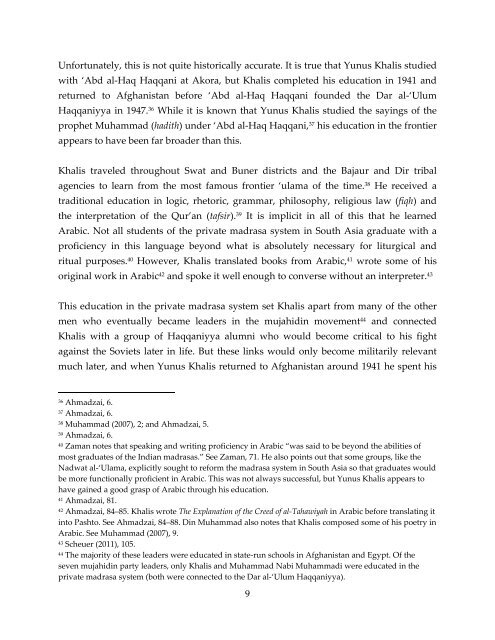Usama bin Ladin’s “Father Sheikh”:
Usama bin Ladin’s “Father Sheikh”:
Usama bin Ladin’s “Father Sheikh”:
You also want an ePaper? Increase the reach of your titles
YUMPU automatically turns print PDFs into web optimized ePapers that Google loves.
Unfortunately, this is not quite historically accurate. It is true that Yunus Khalis studied<br />
with ‘Abd al‐Haq Haqqani at Akora, but Khalis completed his education in 1941 and<br />
returned to Afghanistan before ‘Abd al‐Haq Haqqani founded the Dar al‐‘Ulum<br />
Haqqaniyya in 1947. 36 While it is known that Yunus Khalis studied the sayings of the<br />
prophet Muhammad (hadith) under ‘Abd al‐Haq Haqqani, 37 his education in the frontier<br />
appears to have been far broader than this.<br />
Khalis traveled throughout Swat and Buner districts and the Bajaur and Dir tribal<br />
agencies to learn from the most famous frontier ‘ulama of the time. 38 He received a<br />
traditional education in logic, rhetoric, grammar, philosophy, religious law (fiqh) and<br />
the interpretation of the Qur’an (tafsir). 39 It is implicit in all of this that he learned<br />
Arabic. Not all students of the private madrasa system in South Asia graduate with a<br />
proficiency in this language beyond what is absolutely necessary for liturgical and<br />
ritual purposes. 40 However, Khalis translated books from Arabic, 41 wrote some of his<br />
original work in Arabic42 and spoke it well enough to converse without an interpreter. 43<br />
This education in the private madrasa system set Khalis apart from many of the other<br />
men who eventually became leaders in the mujahidin movement44 and connected<br />
Khalis with a group of Haqqaniyya alumni who would become critical to his fight<br />
against the Soviets later in life. But these links would only become militarily relevant<br />
much later, and when Yunus Khalis returned to Afghanistan around 1941 he spent his<br />
36 Ahmadzai, 6.<br />
37 Ahmadzai, 6.<br />
38 Muhammad (2007), 2; and Ahmadzai, 5.<br />
39 Ahmadzai, 6.<br />
40 Zaman notes that speaking and writing proficiency in Arabic “was said to be beyond the abilities of<br />
most graduates of the Indian madrasas.” See Zaman, 71. He also points out that some groups, like the<br />
Nadwat al‐‘Ulama, explicitly sought to reform the madrasa system in South Asia so that graduates would<br />
be more functionally proficient in Arabic. This was not always successful, but Yunus Khalis appears to<br />
have gained a good grasp of Arabic through his education.<br />
41 Ahmadzai, 81.<br />
42 Ahmadzai, 84–85. Khalis wrote The Explanation of the Creed of al‐Tahawiyah in Arabic before translating it<br />
into Pashto. See Ahmadzai, 84–88. Din Muhammad also notes that Khalis composed some of his poetry in<br />
Arabic. See Muhammad (2007), 9.<br />
43 Scheuer (2011), 105.<br />
44 The majority of these leaders were educated in state‐run schools in Afghanistan and Egypt. Of the<br />
seven mujahidin party leaders, only Khalis and Muhammad Nabi Muhammadi were educated in the<br />
private madrasa system (both were connected to the Dar al‐‘Ulum Haqqaniyya).<br />
9


